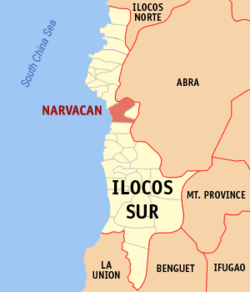- Narvacan, Ilocos Sur
-
Narvacan — Municipality — Map of Ilocos Sur showing the location of Narvacan. Location in the Philippines Coordinates: 17°25′N 120°29′E / 17.417°N 120.483°ECoordinates: 17°25′N 120°29′E / 17.417°N 120.483°E Country  Philippines
PhilippinesRegion Ilocos Region (Region I) Province Ilocos Sur District 2nd District Founded Barangays 34 Government - Mayor Edgardo D. Zaragoza Area - Total 122.21 km2 (47.2 sq mi) Population (2007) - Total 41,578 - Density 340.2/km2 (881.2/sq mi) Time zone PST (UTC+8) ZIP code 2704 Income class 2nd class Website narvacan.gov.ph Population Census of Narvacan Census Pop. Rate 1995 35,489 — 2000 38,435 1.73% 2007 41,578 1.09% Narvacan is a 1st class municipality in the province of Ilocos Sur, Philippines. According to the latest census, it has a population of 41,578 people in 7,803 households.
Contents
Barangays
Narvacan is politically subdivided into 34 barangays.
- Abuor
- Ambulogan
- Aquib
- Banglayan
- Bantay Abot
- Bulanos
- Cadacad
- Cagayungan
- Camarao
- Casilagan
- Codoog
- Dasay
- Dinalaoan
- Estancia
- Lanipao
- Lungog
- Margaay
- Marozo
- Nanguneg
- Orence
- Pantoc
- Paratong
- Parparia
- Quinarayan
- Rivadavia
- San Antonio
- San Jose
- San Pablo
- San Pedro
- Santa Lucia
- Sarmingan
- Sucoc
- Sulvec
- Turod
History
Narvacan was discovered by a Spanish expeditionary force sent from Vigan by the military officer and navigator, Captain Juan de Salcedo. The Spanish expeditionary force was shipwrecked along the town's coast. When they were being rescued by the natives, the Spaniards asked the natives what was the name of their place. The resident's leader replied in an Ilocano dialect by asking the Spaniards "Nalbakan?" (Are you shipwrecked?). The Spaniards thought this to be the answer to their question, and from then on the place was referred to as Narvacan.
Salcedo befriended the small tribe of indigenous valley peoples that resided in the area while Spanish families established a township in 1576. As part of the modern township, a Roman Catholic parish was established by the Augustinian religious order on April 25, 1587. The Narvacan parish would become one of the first Roman Catholic parishes in present-day Ilocos Sur.
Narvacan was organized under the traditions of the royal government of Spain. The Habsburg royal family served as the heads of state which in turn appointed Santiago de Vera as President of the Royal Audiencia — governor over the region in which Narvacan was situated. In 1589, Governor Vera appointed Nicolas de Figueroa as the first Encomendero de Narvacan — principal administrator of the town and its neighbors in the encomienda system. His role eventually evolved into the office of alcalde —
Economy
Situated near the western coastline of the island of Luzon, Narvacan is nestled in a valley surrounded by mountains. A fertile region with a cool tropical climate, the principal crops of Narvacan are corn, cotton, indigo, rice, sugarcane and tobacco.
Culture and language
Its residents are largely Roman Catholic. A sizeable minority of Methodist Christians are present. The local language is Ilocano.
Tourism
The Sulvec beach is a popular lounging spot for vacationers and is near the Narvacan Tourism Lounge.[1] Tourists also visit the Sulvec Watchtower, a brick tower that was built by Spaniards to warn the town of pirates coming from offshore.[2]
Education
The Narvacan School of Fisheries, a branch of the Ilocos Sur Polytechnic State College (ISPSC), has been located in Sulvec since 1964.[3] It is also the base of operations of the Philippine Army’s 503rd Infantry Brigade which oversees the Citizen Armed Forces Geographical Units.[4]
Famous Filipinos from Narvacan
- Pablito Sanidad - Former Vice Governor of Ilocos Sur, Deputy Minister of Labor, National Chairman of the FREE LEGAL ASSISTANCE GROUP (FLAG), Panel Member, GRP Peace Negotiating Panel with the CPP/NPA/NDF, Office of the Presidential Adviser on the Peace Process (OPAPP)
- Ruben C. Sevilleja - President, Central Luzon State University
References
- ^ "Explore Philippines >> Ilocos Sur >> Things to Do". WOW Philippines. http://www.wowphilippines.com.ph/explore_phil/place_details.asp?content=thingstodo&province=2. Retrieved 2008-12-09.[dead link]
- ^ "The Official Website of the Province of Ilocos Sur - Ecohistourism". Provincial Government of Ilocos Sur. 2003. http://www.santa.gov.ph/ilocossur/tourism/trsmattractionsecohistourism.html. Retrieved 2008-12-09.
- ^ "Ilocos Sur Polytechnic State College, Brief History". http://www.tagudin.gov.ph/giispsc.html. Retrieved 9 December 2008.
- ^ "Rebel ‘abuses’ driving people to join Cafgu". Manila Bulletin. 2007-12-27. http://www.manilatimes.net/national/2007/nov/27/yehey/prov/20071127pro1.html. Retrieved 2008-12-09.[dead link]
Cong. Fidel Villanueva Sen. Prospero Sanidad, Cabinet Member of President Elpidio Quirino Cong. Pablo Sanidad Cong. Lucas V. Cauton, retired AFP General and Assemblyman, Interim Batasan Pambansa Gov. Osias Cadiente, Governor of Nueva Vizcaya Brian Viloria, world boxing champion
External links
- Municipality of Narvacan Homepage
- Pasyalang Ilocos Sur
- Philippine Standard Geographic Code
- 1995 Philippine Census Information
- 2000 Philippine Census Information
- 2007 Philippine Census Information
Municipalities Alilem • Banayoyo • Bantay • Burgos • Cabugao • Caoayan • Cervantes • Galimuyod • Gregorio Del Pilar • Lidlidda • Magsingal • Nagbukel • Narvacan • Quirino • Salcedo • San Emilio • San Esteban • San Ildefonso • San Juan • San Vicente • Santa • Santa Catalina • Santa Cruz • Santa Lucia • Santa Maria • Santiago • Santo Domingo • Sigay • Sinait • Sugpon • Suyo • TagudinComponent cities Candon • ViganCategories:- Municipalities of Ilocos Sur
Wikimedia Foundation. 2010.


